Have you ever heard of the Benin Ivory Masks? Stick around let's get into the details.
INTRODUCTION
Benin is another ancient kingdom that is currently the capital city of Edo state of Nigeria. It was one of the oldest and most developed empires in that area of West Africa, having been formed at about the 11th Century A.D and it was annexed by the British in 1897.
Benin had its own art just like the Ife people, although the Benin Bronze works were done using the Lost Wax method which they learned from the people of Ife. However, Benin Art is semi-naturalistic, being more stylized than Ife Art. I guess the student does not always surpass the master. Here are some samples:
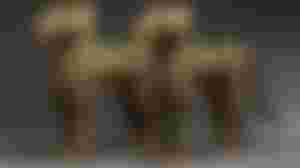

But we aren't here to talk about Benin Art in general, but about a very special work. The Ivory Mask of the Queen Idia, the first Queen Mother, or Iyoba, of the 16th Century Benin Empire.
WHERE ARE THE MASKS?
In actuality, there were quite a few of these masks, I'm only sure of about three, and sadly, none of them are in Nigeria. You see, I'm about to take you down a bit of sad history here.
THE PUNITIVE EXPEDITION OF 1897
I might not be able to explain the whole thing in detail, but here's just a brief rundown of what went down.
As of 1862, Benin was one of the only Independent West African kingdoms and the Oba had a monopoly of trade in the area, and this irked the British, who described it as a place or barbarity and death because men and women slaves were offered as human sacrifices.
The British claimed they wanted to annex and take control of the empire for the progression of civilization, which in part was true, but they also had other ideas, like the collection of the precious Ivory located there.
The British tried again in 1892 to open up trade and ultimately bring Benin to subjugation by signing a treaty with Ovonramwen, who was the King, or Oba, at the time. This treaty justified Britain to exert greater influence over the empire. I don't know if OIvonramwen really understood what he was signing, the facts from letters between British administrators shows that Britain's move was more economic than humanitarian.

Some sites cite that the Oba was forced to sign this treaty and that the British man who drafted it said the Benin Kingdom did so to gain 'protection' from the British, which was just outrageous.
Oba Ovonramwen doublecrossed - the treaty said 'free-trade', but he went on collecting customs duties. The Benin people were wary of the British and strengthened their military defenses when they discovered that the British had attacked and destroyed a close trading town.
An expedition was slated for 1896, but because Benin was vigilant and the Colonial Office disapproved of it, it was canceled. Still, between 1895-1896, efforts were made thrice to enforce the treaty, all to no avail.
But then, a trade embargo placed by Ovonramwen in 1996 was the final straw. This embargo closed trade along the Benin River, and it was caused by another group's refusal to pay tributes. The British then agitated for the embargo to be forcefully lifted and the Oba to be sent into exile, as he was an 'obstruction' to them.
The acting Consul-General, one Phillips, then decided to invade the Benin Kingdom, even when he had not received a go-ahead order from Britain. He moved in December 1996 with a total of 255 men, 250 of whom were African soldiers disguising as porters and musicians. The weapons were hidden in the luggage held by the 'porters'.
Funny enough, Phillips planned to pay for the expedition with the Ivory he was going to steal from the Oba's palace. He told the Oba he was coming to discuss trade and peace amongst other things.
However, neighboring towns went to tell the Oba that the British were bringing war. An emergency meeting was held, and the commander of the army decided they should launch a surprise attack on the British. Ovonramwen was unsure, citing that they should first allow the British to enter so that their purpose may be confirmed.
Whether this the right or wrong move, I cannot say, but the Army Commander ignored this decision and went on to attack the men at a community in January 1897. Since Phillips didn't expect an attack and did not know his activities were suspected in Benin, he was not ready, and their group was annihilated. Only two officers survived to return to Britain with the news.
In February 1897, the British returned with 1200 men and one goal - destruction of the Benin Empire. For over three days, they set fire to the kingdom, and this fire grew out of control. The Benin Kingdom had a wall which was, at one point, four times the length of the Great Wall of China. Little remains of that wall today.

After that, the looting of the Ivory pieces began, and the Idia masks were part of the artifacts looted. Today, there's very few left to identify the remains of this great Kingdom.
Oba Ovonramwen died in exile in the coastal area of Calabar in 1914, which was the same year the Northern and Southern protectorates were amalgamated to form the country that is now called Nigeria.
WHO WAS QUEEN MOTHER IDIA?
She was the mother of Oba Esigie. He had two conflicts - one during the ascension to the throne, and another, which was a war, during his time as King. She, however, was his advisor during this period and was known as the only woman who went to war. This made him give her the title of Iyoba or Queen Mother.
PROPERTIES OF THE MASK
Finally, you get to see the mask I've been talking about.
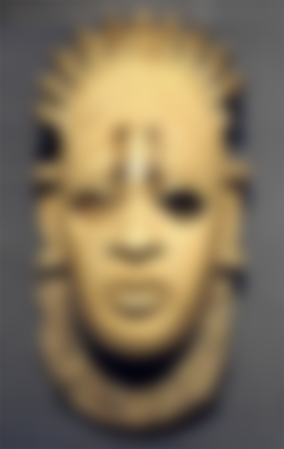

First, we have the marks above the orbits of her eyes - those are facial scarifications or tribal marks which was common to Benin women at the time.
The headdress and neck choker are from the coral royal beads. They were red in color, but today, the red cloth and dress are worn by all Edo people as they like during traditional festivities. Those beads were usually only worn by the Oba and his War Chief, but it was Queen Idia's special privilege to wear them.
The mask features the serene, calm look of a young woman, with the nostrils flared and the mouth thin, perhaps to indicate her firm, confident and bold nature. Idia was held in high esteem and reverence by the Oba and his people.
She also invented a Parrot-Head style of headdress, which is visible in the Bronze head, as seen here.

The bronze heads were made after her death and mounted in front of altars and the Palace of the Queen Mother. The masks were worn by the Oba during certain ceremonies, and they usually contained amulets.
MODERN-DAY
Oba Akenzua II (1899 - 1978) began the movement for the return of the Benin Bronzes from Britain in 1936. Out of 3000 pieces, only 2 were returned during his reign. However, in the late 1930s, two coral crowns and a coral dress touted to belong to Ovonramwen were returned by one G. Miller, who was the son of one of the members of the expedition.
In 1977, The Festival of Arts and Culture or FESTAC was held in Lagos. The Nigerian Government tried to loan the mask from the British Museum but were refused. (I'm totally passed off at this moment).
They had to resort to a replica made by the sculptor and painter Erhabor Emokpae. Again, I'm totally pissed here.
The 2017 Movie Black Panther featured a replica of the artwork filmed at a place that was supposed to be the British Museum. You can watch it here at the exact timestamp.
Also, the Black Panther mask was created by a mix of different Benin Masks and artworks, and the movie also has different masks from other African cultures.
I hope you enjoyed this long narrative! Thanks!
Images sourced from Wikipedia unless designated otherwise. The picture of Oba Ovonramwen is from Brittanica.
EXTRA LINKS FOR FURTHER RESEARCH
https://www.omokoshaban.com/2019/12/10/after-117-years-a-stolen-statues-return-to-nigeria/
https://en.wikipedia.org/wiki/Benin_ivory_mask#:~:text=The%20Benin%20ivory%20mask%20is,Art%20in%20New%20York%20City.
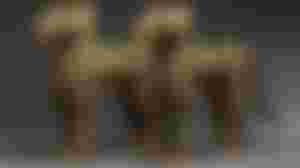



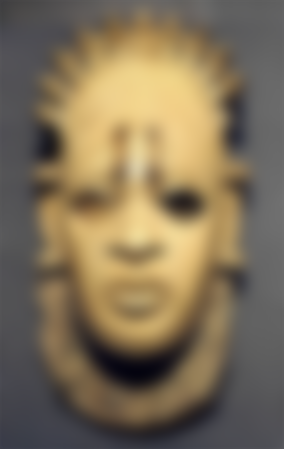
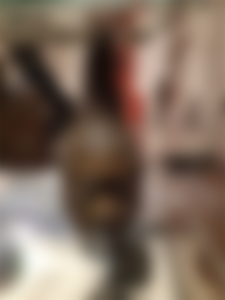
The British people are so selfish yet those relics aren't even theirs to begin with. Such a high and mighty air for stolen artifacts, really